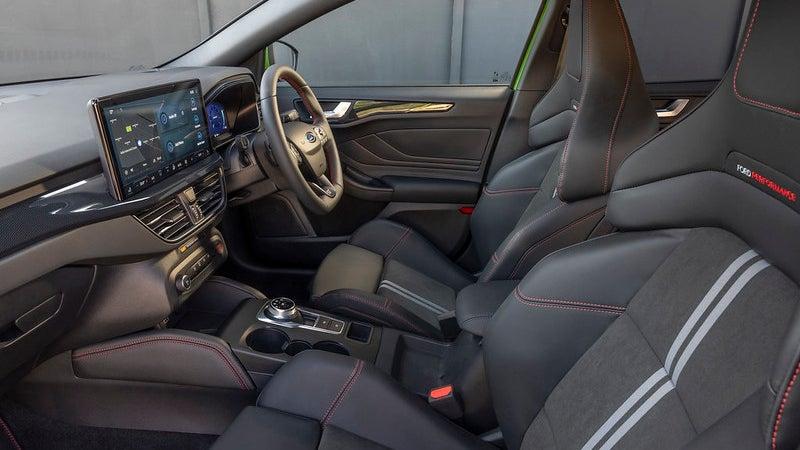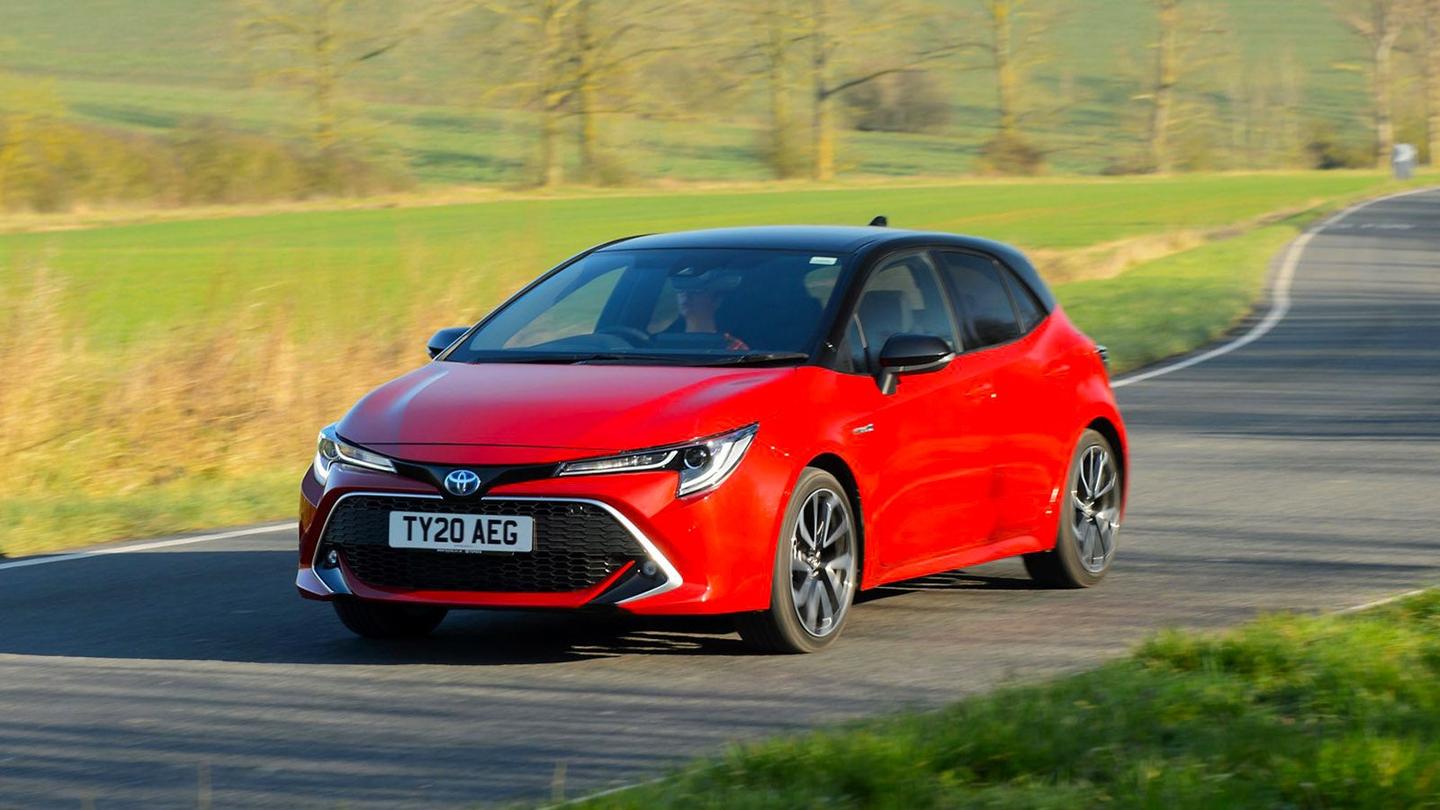
Ford Focus interior, tech and practicality
Gallery
Comfort and visibility
The Focus isn’t going to be one of those cars that makes you want to stroke every bit of trim and marvel at a space-age infotainment setup – but then, who does that anyway? More often than not, your car is going to be a tool that’ll get you to work, or other mundane journeys.
And that’s where the Focus’ logical interior comes into its own. Sure, it may not have quite the visual pizazz of a Mazda 3 or Audi A3, but everything is easy to use and right where you’d expect it. There are quite a few buttons on the steering wheel, but they’re clearly labelled and you shouldn’t find that you’re hitting the wrong controls too often. All the climate controls are illuminated so you can use them at night, which isn’t the case in the 2020-2024 Volkswagen Golf.
Comfort is great – there’s plenty of seat and wheel adjustment, and the sports seats in ST-Line models feel nice and snug. The ride is on the right side of firm and the engines are quiet, which makes for a refined and grown-up driving experience. With slim front pillars and a fairly flat windowline, all-round visibility is perfectly decent.
Standard equipment
When the Focus was launched, you could choose a sparse Style trim that had few highlights besides auto headlights, DAB radio, air con and lane-keep assist. Next up was Zetec with alloy wheels, cruise control, a heated windscreen – a lifesaver on cold winter mornings – and a touchscreen with Apple CarPlay and Android Auto. These were both discontinued, as was the 2022-only Trend trim that essentially replaced Zetec.
Titanium used to be described as a ‘luxury’ trim by Ford but, with no cheaper versions on offer, it’s now the entry-level trim. Still, with auto wipers, heated front seats, two-zone air con, keyless entry and sat nav, it offers enough creature comforts to keep most buyers happy.
Titanium X ups the size of the wheels by an inch and adds tinted rear windows and part-leather trim with electric adjustment for the driver’s seat. Cars produced from 2022 add wireless phone charging, a digital driver’s display and a 10-speaker B&O sound system, which were previously exclusive to the Vignale trim.

Vignale is Ford’s attempt to turn the Focus into an Audi A3 and BMW 1 Series rival, with exclusive leather trim, ambient lighting and a chromed front grille. You also get LED headlights, a head-up display, a heated steering wheel and active parking assistance. When the Focus was overhauled, Vignale became an option pack on Titanium, ST-Line and Active trim levels, rather than the standalone trim level it was before.
ST-Line is Ford’s sporty trim, giving you the looks of the full-fat ST without the full-fat running costs. Besides a more aggressive bumper, you get sports suspension and eye-catching red stitching. Early ST-Lines had the same spec as Zetec, so missed out on sat nav and parking sensors, but Ford has gradually added more equipment throughout the car’s time on sale. ST-Line X mirrors Titanium X, with bigger wheels in a two-tone design and a similar level of equipment.
Active trims give the Focus a dash of crossover style, courtesy of roof rails, black lower body trim and a slightly raised ride height. It’s no swamp-crossing 4x4, but its taller proportions may make it easier to get in and out than a standard Focus. Active sits somewhere between Zetec and Titanium in terms of equipment, and gets trim-specific badging and seats. Active X, like the other X trims, adds more kit without really changing the styling.
Topping the range is the ST hot hatch, with grey bumper trim, 19-inch grey alloy wheels, red brake calipers, branded sports seats, carbon fibre-effect interior trim and upgraded headlights. Its sports seats hug you tight, so make sure you’re happy with the bolstering before you buy.
Infotainment and audio
Besides the base-spec Style and some early cars, all 2018-2022 Focuses get an eight-inch touchscreen mounted on top of the dashboard running Ford’s ‘Sync 3’ infotainment system. It looks a little like Ford forgot to integrate the screen and simply plonked an iPad above the climate controls, but it’s pretty simple to use and easy to read. If you feel the screen is too bright or too distracting, especially at night, you can turn the display off and keep the infotainment and radio going.
The touchscreen uses a grid of tiles with links to the audio settings, Bluetooth connectivity and more, plus a row of icons that act as shortcuts to the navigation, phone mirroring and media playback. Generally they’re big enough to make them easy to hit on the move, although some rivals like the Skoda Octavia have a more prominent ledge to steady your hand. It could also be easier to find your favourite radio station, but those are small gripes with an otherwise competent system.

An eight-inch screen was considered fairly big when the Focus launched but, such is the rate of progress, it’s starting to feel on the small side compared to some family hatches. So, in the 2022 facelift, the Focus gained a massive 13.2-inch screen with Ford’s latest Sync 4 system (unless you find a car affected by the automotive chip shortage of 2021). This is more like a TV screen than a tablet – a crisp, expansive display that includes new connectivity features such as Alexa integration. The navigation system can also learn your favourite destinations and give you live information on local traffic, weather and parking space availability.
You can also remotely lock and unlock the car using the FordPass Connect phone app, along with checking vehicle data and when your next service is due.
We like the way the infotainment looks and how easy it is to find points of interest on the sat nav – it’ll take you straight to your local Motorpoint store if you ask it to – but the screen could definitely be a little bit faster to respond. The old chunky dials for the air conditioning have been replaced by small, touch-sensitive ‘buttons’ at the base of the screen, which can be hard to hit while you’re driving.
It’s a similar story with the digital instrument cluster. It looks great, but it’s nowhere near as configurable as the displays in SEAT and Peugeot models. With the screen always showing a digital version of traditional dials, you might wonder what the point of it is.
While the standard audio system is decent enough, audiophiles will want to grab a version of the Focus that comes with a B&O premium sound system with 10 speakers and 360-degree sound technology.
Rear seat space

The Focus does pretty well for rear seat space, feeling like a limousine compared to the last-generation car. Among contemporary rivals, the Focus has one of the most spacious rear benches – it’s much more accommodating than a Mercedes A-Class or Toyota Corolla. There’s enough legroom for a tall adult to comfortably sit behind another tall adult, although the tallest passengers will find headroom a bit tight. If you’re of more average height, your head won’t be brushing the roof. Sitting three adults across the rear seats is possible, but everyone will feel a bit squashed.
On the plus side, it manages to avoid feeling claustrophobic in the rear seats, instead feeling quite airy and spacious. The fairly flat windowline helps with that, and should enable young children to see outside. A couple of USB sockets for charging kids’ tablets wouldn’t go amiss, though.
Boot space

At 375 litres, the Focus’ boot is five litres down on the Volkswagen Golf and SEAT Leon – a difference you’ll never notice in real life. The boot is a great shape, being usefully square and accessed through a wide boot opening. There’s a bit of a lip to haul heavy items over, but then the car’s lower ride height versus an SUV will make it easier to load bulky things. That also makes it easier for a dog to jump in the boot, too, if that’s a consideration you’re making.
If the hatchback’s boot isn’t quite big enough, the Ford Focus Estate will be ideal. Its 593-litre boot is much larger than even the Kuga SUV, and is one of the biggest boots in the small estate class. The boot floor can be used as a divider to keep two sections separate. Fold the rear seats down and you’ll be able to make use of 1,620 litres of space – 300 more than the hatchback.






















































